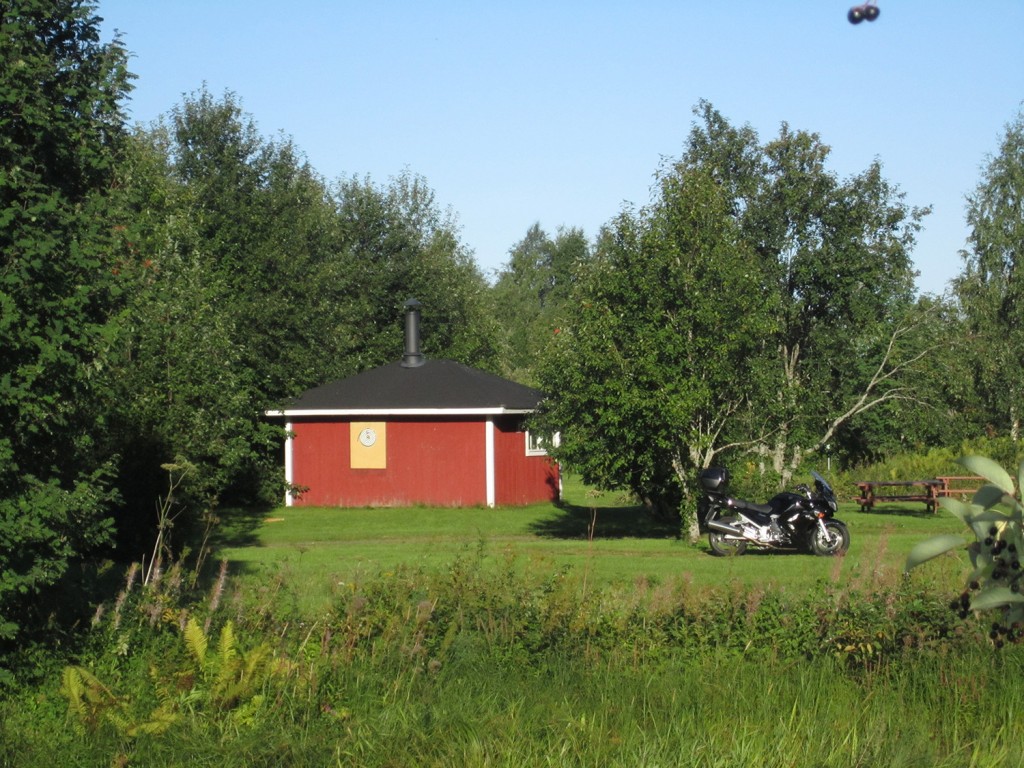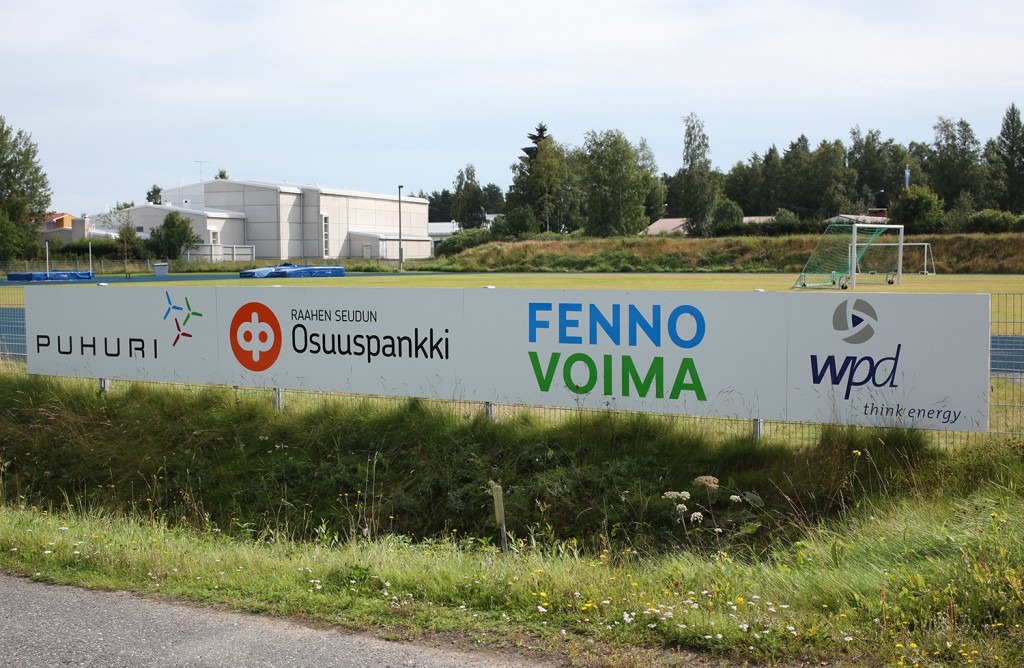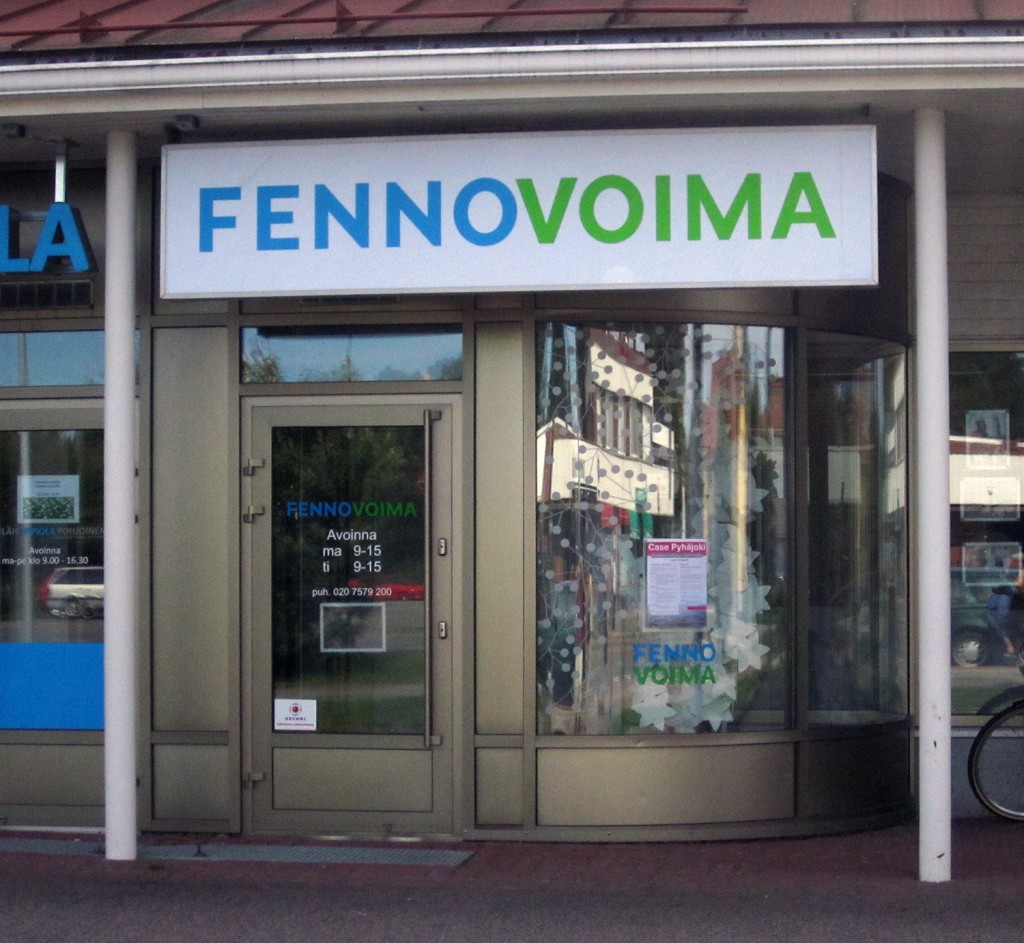FENNOVOIMA’s Image Washing, Manipulating Public Opinion & Normalizing Their Presence
This was written for Case Pyhäjoki’s blog. It is a reflection on the use of deceptive tactics to encourage a community to accept a nuclear power plant.
Fennovoima signs adorn public works in Pyhäjoki, like the fence of this sports field near the town’s high school where Case Pyhäjoki is taking place. The name of the corporation is split in two in this sign. The colors chosen slowly make one think of a clean sky blue and verdant earth green. The minimalist, sans serif, ultra-clean logo contributes to the branding narrative. These qualities together help to subtly reinforce a deceptive and cynical picture of the false ecological story of nuclear power: its advocates claim it is “green” because it does not produce carbon emissions in the generation of energy. Fennovoima’s waste is far more deadly, and is a threat to the entire planet in ways that localized carbon emissions are not. This is classic green washing part of a broader strategy to help mask the reality of the true costs of making energy in this way.

For those unfamiliar with the Finnish landscape, this is a typical scene of blue skies, green grass, and a rural building painted red.
The plant that Fennovoima wants to build would destroy the lush, fragile biodiversity of the forest and seaside land it intends to occupy, not to mention produce untold amounts of stress and depression for those who do not want it. The carbon footprint of building and servicing such a plant is tremendous. It is also important to think about how much carbon will be generated in mining uranium and the long term handling of waste. The plant would destroy the land base at Hanhikivi and forever degrade and impoverish it, removing forest that helps mitigate climate change. We need more trees instead of power plants. The building of the plant would include dredging the sea bed up to 5 m deep for cooling the reactors. Instead of mining uranium, it should stay buried in the ground. The destruction of multiple land and sea areas is one of the harsh realities Fennovoima seeks to distract us from thinking about. This company is devious in how it tells the public about its activities. It also has no idea what it will do with the waste it produces and wants us to take comfort in the fact that companies are still talking about the best way to do this. This is shocking.
Fennovoima uses the funding of public works and other strategies to attempt to manipulate public opinion about the destructive business they are in. They funded the sports field (in the picture featured with this post), an ice hockey team, and a baseball team. When pressed to disclose how much they spent on these things the answer was that this was private information and we could not find out. In addition to funding sports, Fennovoima hosts fair days in the local high school and has “theme nights” in the company’s local office so experts can talk about power plant-related issues.
Fennovoima is working hard to normalize their presence in the area. They have a storefront office that is open to the public on Mondays and Tuesdays each week to put a friendly face in the town. The same “green” logo is plastered multiple times on the building’s façade. The office has stacks of brochures in Finnish and English spreading the company’s story telling, for example, how its employees are slowly integrating into the local community. Fennovoima wants people to see them as a part of the community, a benevolent power, rather than the aggressive bullies that they are.
Fennovoima has claimed that it will not go where it is not wanted, but this is a false statement. There is strong resistance to the development of a nuclear power plant by a large percentage of the population. Residents who do not want to sell, or discontinue their leases on land where the plant is to be built, are facing legal actions to remove them. According to Pro Hanhikivi, an organization fighting the nuclear power plant, Fennovoima, for the first time in Finnish history, is trying to expropriate private persons’ land for private purposes. Most likely Fennovoima won’t do this themselves, but will rely on the municipality to make it happen.
Radio Aktiv Sonic Deep Map (2013)

SUPERKILEN – Extreme Neoliberalism Copenhagen Style

Read Brett's essay about the park.
Download our guide:

This is our guide to how-to books from the counterculture of the 60s and 70s. Click to get the download page.
Categories
- Agriculture (11)
- Animal sounds (1)
- Artist parents (19)
- Arts and culture (106)
- Bees (3)
- Book reviews (14)
- Books (18)
- Critical essays (5)
- Daily Photo (5)
- Design (36)
- Dirt (11)
- Environmental activism (43)
- Exhibitions (24)
- Farms (11)
- Forest (7)
- Friday connect (15)
- Growing (42)
- Habitat (38)
- Homesteading (16)
- Interviews (15)
- Kitchen (14)
- Living structure (9)
- MISC (15)
- Mythological (2)
- Neighborhood (83)
- Ocean News (1)
- Our Art Work (21)
- Personal – Design/Art (3)
- Play (2)
- Playground (4)
- Projects (21)
- Public space (53)
- Resilience (13)
- Sea Side (2)
- Sojabønner (2)
- Tofu (8)
- Vermont correspondence (7)
- Water (3)
- Wednesday picture (31)
- Workshop (1)
Video interview:

Watch our interview of SeedBroadcast, a mobile project that is part seed library and part seed-saving-story-collecting machine-recording the stories of seed saving, farming, and food sovereignty work being done around the US.

Download a poster Bonnie made about biodiversity in a vacant lot in the Amager borough of Copenhagen, in collaboration with biologist, Inger Kærgaard, ornithologist, Jørn Lennart Larsen and botanist, Camilla Sønderberg Brok: A BRIEF TAXONOMY OF A LOT

We made and installed a network of bat houses in Urbana, Illinois, to support the local and regional bat population, but also to begin a conversation about re-making the built environment.
READ MORE
BOOK REVIEW:

We write often about artists and art groups that work with putting ‘culture’ back in agriculture. Here is a new favorite: myvillages, a group of three women based in Germany, the Netherlands, and the UK. Read more...

Post Revolutionary Exercises
We really admire the dedicated hard work of Kultivator who seeks to fuse agriculture and art in their work. Click this sentence to get a PDF of their poster collection called "Post Revolutionary Exercises."

Cultural Practices Within And Across
This amazing book networks urban and rural resilience and sustainability projects around the world. Deeply inspiring projects in Romania, Paris, San Francisco, and elsewhere.
• Read our review of the book.
• Buy the book.
• Download the book.









